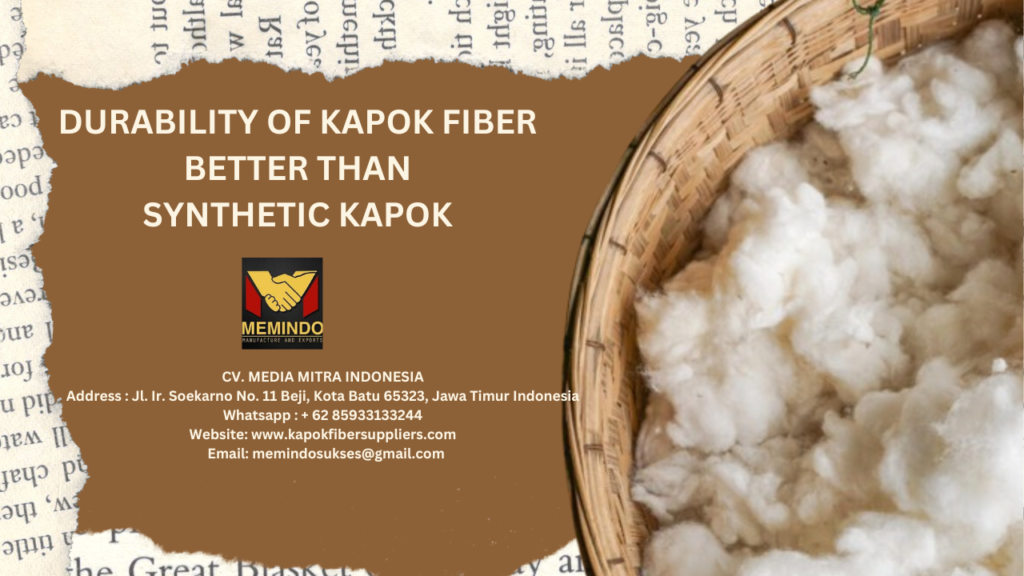When comparing the durability of kapok fiber to synthetic alternatives, it’s important to consider several factors such as longevity, resilience, and overall performance in various applications. Here’s a detailed look at how kapok fiber stacks up against synthetic materials:

1. Durability and Longevity
– Kapok Fiber:
– Natural Resilience: Kapok fiber is known for its natural resilience and ability to retain its shape. It provides good support and comfort over time, making it suitable for applications like cushions, pillows, and mattresses.
– Compression Resistance: While kapok is soft and fluffy, it generally maintains its structure and does not compress as quickly as some synthetic materials. However, it can still lose some loft over prolonged use.
– Synthetic Kapok
– Consistency: Synthetic fibers, such as polyester, are engineered for durability and consistency. They tend to retain their shape and structure longer without compressing as much as natural fibers.
– Longevity: Synthetic materials are often designed to be highly durable and resistant to wear and tear. They generally offer more resistance to compression and are less affected by moisture compared to natural fibers.
2. Performance Over Time
– Kapok Fiber:
– Natural Wear: Over time, natural kapok fiber can experience some breakdown and loss of loft, especially if exposed to moisture or heavy use. It can become compacted, but it remains breathable and maintains its hypoallergenic properties.
– Maintenance: Kapok-filled products require proper maintenance to prevent moisture buildup and potential mold issues, which can affect their longevity.
– Synthetic Kapok
– Resistance to Moisture: Synthetic fibers are less susceptible to moisture and mold, which can enhance their durability in damp conditions. They tend to maintain their performance and structure over time, even with frequent use.
– Maintenance: Synthetic materials are typically easier to maintain and clean, as they are more resistant to staining and moisture-related issues.
3. Environmental Impact and Sustainability
– Kapok Fiber
– Biodegradability: Kapok fiber is biodegradable and compostable, meaning it will eventually break down in the environment. While this is a positive trait for sustainability, it also means that kapok products may not last as long as synthetic alternatives under certain conditions.
– Sustainability: Kapok is a renewable resource and supports ecological balance, but its durability can be impacted by environmental factors.
– Synthetic Kapok:
– Non-Biodegradable: Synthetic fibers are not biodegradable and can contribute to environmental pollution. While they may last longer, their end-of-life disposal can be problematic due to their persistence in landfills.
– Environmental Impact: The production of synthetic fibers often involves significant energy use and chemical processing, which can have a higher environmental impact compared to natural fibers.
4. Comfort and Performance
– Kapok Fiber
– Comfort: Kapok provides a high level of comfort and support, with a natural fluffiness that many people find appealing. It can adapt to the shape of the body, making it a popular choice for bedding and upholstery.
– Breathability: Kapok is highly breathable, which helps in regulating temperature and reducing moisture buildup, contributing to a comfortable sleep environment.
– Synthetic Kapok
– Consistency: Synthetic fibers often provide a more uniform feel and performance, with consistent support and less variation compared to natural fibers. They are designed to mimic the properties of natural fibers while offering durability.
– Breathability: Synthetic materials can vary in breathability, and some may not provide the same level of temperature regulation as natural fibers.
Conclusion
Kapok fiber offers a blend of natural resilience, comfort, and eco-friendliness, but its durability may not always match that of synthetic alternatives, particularly in terms of compression resistance and moisture resistance. Synthetic fibers, such as polyester, tend to have superior durability and performance in harsh conditions and are less affected by moisture. However, they come with environmental drawbacks, including non-biodegradability and higher production impacts.
Choosing between kapok and synthetic fibers often comes down to prioritizing sustainability and comfort versus durability and ease of maintenance. For those who value environmental impact and natural properties, kapok fiber remains a strong choice despite its potentially shorter lifespan compared to synthetic options.
CV. MEDIA MITRA INDONESIA
Address : Jl. Ir. Soekarno No. 11 Beji, Kota Batu 65323, Jawa Timur Indonesia
Whatsapp : + 62 85933133244
Website: www.kapokfibersuppliers.com
Email: memindosukses@gmail.com
Source by : Zulfan Arya Nurdiansyah
